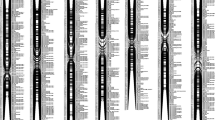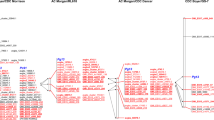Abstract
Marker-assisted selection for traits that are difficult to screen for, such as resistance to many sugarcane diseases, has the potential to facilitate the development of improved cultivars in sugarcane. Pachymetra root rot (PRR) and brown rust resistance ratings were obtained over two years for 192 I1 progeny (progeny produced by two heterozygous, non-inbred parental lines) of a sugarcane (Saccharum spp. hybrid) cross between two elite sugarcane clones, Q117 and 74C42. Approximately 1000 single-dose markers, including microsatellite (SSR), amplified fragment length polymorphism (AFLP) and restriction fragment length polymorphism (RFLP) markers, were scored across the population and maps containing approximately 400 markers were constructed for each parent. At p ≤ 0.01, two genomic regions, one from the female Q117 map and a different region from the 74C42 male map, plus an unlinked bi-parental simplex marker (single-dose marker present in both parents) were identified as associated with PRR over both years of data collection. These regions explained between 6 and 16% of the phenotypic variation. An additional region was identified in the female map as associated with PRR at p ≤ 0.01 in one year and p ≤ 0.05 in the second year. This region explained between 4 and 8% of the phenotypic variation. For brown rust, two genomic regions, one from the female map and one from the male map, plus an unlinked marker from both maps, were identified as associated with brown rust resistance at p ≤ 0.01 over two years of phenotypic data. Each region explained between 7 and 18% of the phenotypic variation. Several additional regions were identified in both maps as associated with brown rust at p ≤ 0.01 in one year and p ≤ 0.05 in the second year. These regions also explained between 5 and 11% of the phenotypic variation. To validate these markers and determine whether they would be useful in alternative germplasm, markers from each genomic region associated with PRR or brown rust were screened across a set of 154 elite sugarcane clones; PRR and brown rust ratings were available for 131 and 72 of the clones, respectively. For PRR, three of the 6 markers tested remained significantly associated (p ≤ 0.01) with resistance ratings in the elite clone set. For brown rust, only one of the seven markers tested remained significantly associated (p ≤ 0.01) with resistance in the elite clone set, with one other marker associated at p ≤ 0.05. These results suggest that these markers could be broadly effective in selecting for PRR and/or brown rust resistance in sugarcane breeding programs.
Similar content being viewed by others
References
K. Aitken P.A. Jackson C.L. McIntyre (2005) ArticleTitleConstruction of a genetic linkage map of a sugarcane cultivar (Saccharum spp.) using AFLP and SSR markers Theor. Appl. Genet. 110 789–801 Occurrence Handle15700149 Occurrence Handle10.1007/s00122-004-1813-7 Occurrence Handle1:CAS:528:DC%2BD2MXislantLo%3D
S.M. Al-Janabi R.J. Honeycutt M. McClelland W.S. Sobral (1993) ArticleTitleA genetic linkage map of Saccharum spontaneum L. ‘SES 208’ Genetics 34 1249–1260
G.M. Cordeiro G.O. Taylor R.J. Henry (2000) ArticleTitleCharacterisation of microsatellite markers from sugarcane (Saccharum sp.), a highly polyploid species Plant Sci. 155 161–168 Occurrence Handle10814819 Occurrence Handle10.1016/S0168-9452(00)00208-9 Occurrence Handle1:CAS:528:DC%2BD3cXjt1aqtbg%3D
B.J. Croft (1989) ArticleTitleA technique for screening sugarcane cultivars for resistance to Pachymetra root rot Plant Dis. 73 651–654 Occurrence Handle10.1094/PD-73-0651
J.A.G. Da Silva R. Honeycutt W.L. Burnquist S.M. Al-Janabi M.E. Sorells S.D. Tanksley B.W.S. Sobral (1995) ArticleTitle Saccharum spontaneum L. “SES 208” genetic linkage map combining RFLP- and PCR- based markers Mol. Breed. 1 165–179 Occurrence Handle10.1007/BF01249701
J.H. Daugrois L. Grivet D. Roques J.Y. Hoarau H. Lombard J.C. Glaszmann A. D’Hont (1996) ArticleTitleA putative major gene for rust resistance linked with a RFLP marker in sugarcane cultivar ‘R570’ Theor. Appl. Genet. 92 1059–1064 Occurrence Handle10.1007/BF00224049 Occurrence Handle1:CAS:528:DyaK28XltFOnurk%3D
A. D’Hont P.S. Rao P. Feldmann L. Grivet N. Islam-Faridi P. Taylor J.C. Glaszmann (1995) ArticleTitleIdentification and characterisation of sugarcane intergeneric hybrids, Saccharum officinarum × Erianthus arundinaceuswith molecular markers and DNA in situ hybridisation Theor. Appl. Genet. 91 320–326
A. D’Hont L. Grivet P. Feldmann S. Rao N. Berding J.C. Glaszmann (1996) ArticleTitleCharacterization of the double genome structure of modern sugarcane cultivars (Saccharum spp.) by molecular cytogenetics Mol. Gen. Genet. 250 45–413
M.W. Dick J.J. Croft R.C. Magarey G. Clark (1989) ArticleTitlePachymetraa new genus of the Verrucalvaceae (Oomycetes) Bot. J. Linnanean Soc. 99 97–113 Occurrence Handle10.1111/j.1095-8339.1989.tb00394.x
C. Gebhardt A. Ballvora B. Walkemeier P. Oberhagemann K. Shuler (2004) ArticleTitleAssessing genetic potential in germplasm collections of crop plants by marker-trait association: a case study for potatoes with quantitative variation of resistance to late blight and maturity type Mol. Breed. 13 93–102 Occurrence Handle10.1023/B:MOLB.0000012878.89855.df Occurrence Handle1:CAS:528:DC%2BD2cXkt1Kkuw%3D%3D
D. Grattapaglia R.R. Sederoff (1994) ArticleTitleGenetic linkage maps of Eucalyptus grandis Eucalyptus urophylla using a pseodo testcross: mapping strategy and RAPD markers Genetics 137 1121–1137 Occurrence Handle7982566 Occurrence Handle1:CAS:528:DyaK2MXmslWltw%3D%3D
J.Y. Hoarau L. Grivet B. Offmann L.-M. Raboin J.-P. Diorflar J. Payet M. Hellmann A. D’Hont J.C. Glaszmann (2002) ArticleTitleGenetic dissection of a modern sugarcane cultivar (Saccharum spp.). II. Detection of QTLs for yield components Theor. Appl. Genet. 105 1027–1037 Occurrence Handle12582930 Occurrence Handle10.1007/s00122-002-1047-5
J.Y. Hoarau B. Offmann A. D’Hont A.-M. Risterucci D. Roques J.C. Glaszmann L. Grivet (2001) ArticleTitleGenetic dissection of a modern sugarcane cultivar (Saccharum spp.). I. Genome mapping with AFLP markers Theor. Appl. Genet. 103 84–97 Occurrence Handle10.1007/s001220000390 Occurrence Handle1:CAS:528:DC%2BD3MXmsV2msb8%3D
D.M. Hogarth C.C. Ryan J.C. Skinner (1983) ArticleTitleInheritance of resistance to rust in sugarcane –comments Field Crop Res. 7 313–316 Occurrence Handle10.1016/0378-4290(83)90039-4
D.M. Hogarth C.C. Ryan P.W.J. Taylor (1993) ArticleTitleQuantitative inheritance of rust resistance in sugarcane Field Crop Res. 34 187–193 Occurrence Handle10.1016/0378-4290(93)90006-9
D.A. Hoisington (1992) Laboratory protocols CIMMYT Applied Molecular Genetics Laboratory MexicoD.F. CIMMYT
N. Jannoo L. Grivet M. Seguin F. Paulet R. Domainge P.S. Rao A. Dookun A. D’Hont J.C. Glaszmann (1999) ArticleTitleMolecular investigation of the genetic base of sugarcane cultivars Theor. Appl. Genet. 99 1053–1060 Occurrence Handle10.1007/s001220051414 Occurrence Handle1:CAS:528:DyaK1MXotVCisL8%3D
D.R. Jordan R.E. Casu P. Besse B.C. Carroll N. Berding C.L. McIntyre (2004) ArticleTitleMarkers associated with stalk number and suckering in sugarcane co-locate with tillering and rhizomatousness QTLs in sorghum Genome 47 983–988 Occurrence Handle10.1139/g04-040
C.L. McIntyre S. Hermann R.E. Casu D. Knight J. Drenth Y. Tao S. Brumbley I.D. Godwin S. Williams G.R. Smith J.M. Manners (2004) ArticleTitleHomologues of the maize rust resistance geneRp1-Dgenetically associated with a major rust resistance QTL in sorghum Theor. Appl. Genet. 109 875–883 Occurrence Handle15156283 Occurrence Handle10.1007/s00122-004-1702-0 Occurrence Handle1:CAS:528:DC%2BD2cXntFGnsrs%3D
R.S. McLeod G.G. McMahon P.G. Allsopp (1999) ArticleTitleCosts of major pests and diseases to the Australian sugar industry Plant Prot. Quarterly 14 42–46
R.C. Magarey (1994) ArticleTitleEffect of Pachymetra root rot on sugarcane yield Plant Dis. 78 475–477 Occurrence Handle10.1094/PD-78-0475
R.C. Magarey (1996) ArticleTitleMicrobial aspects of sugarcane yield decline Aust. J. Agric. Res. 47 307–322 Occurrence Handle10.1071/AR9960307
R.C. Magarey J.I. Bull (2003) ArticleTitleRelating cultivar Pachymetra root rot resistance to sugarcane yield using breeding selection trial analyses Aust. J. Exp. Agric. 43 617–622 Occurrence Handle10.1071/EA02144
Magarey R.C., Bull J.I., Neilsen W.A. and Magnanini A.J. 2002. The use of breeding trials to estimate disease-induced yield losses and to refine selection strategies. Proc. Aust. Soc. Sugar Cane Technol. 24: CD-ROM.
R.C. Magarey P.W.J. Taylor C.C. Ryan (1987) ArticleTitleDistribution of the root rot fungus involved in Poor Root Syndrome in cane fields from Ingham to Rocky Point Proc. Aust. Soc. Sugar Cane Technol. 9 105–107
Meer J.M., Manly K.F. and Cudmore R.H. 2002. Software for genetic mapping of mendelian markers and quantitative traits loci. Roswell Cancer Park Institute.
R. Ming Y.-W. Wang X. Draye P.H. Moore J.E. Irvine A.H. Paterson (2002) ArticleTitleMolecular dissection of complex traits in autopolyploids: mapping QTLs affecting sugar yield and related traits in sugarcane Theor. Appl. Genet. 105 332–345 Occurrence Handle12582536 Occurrence Handle10.1007/s00122-001-0861-5 Occurrence Handle1:CAS:528:DC%2BD38Xntlejsro%3D
J. Mudge W.R. Andersen R.L. Kehrer D.J. Fairbanks (1996) ArticleTitleA RAPD genetic map of Saccharum officinarum Crop Sci. 36 1362–1366 Occurrence Handle10.2135/cropsci1996.0011183X003600050046x Occurrence Handle1:CAS:528:DyaK28XmsFCkurs%3D
G. Piperidis A. D’Hont (2001) ArticleTitleChromosome composition analysis of various Saccharum interspecific hybrids by genomic in situ hybridisation (GISH) International Society of Sugar Cane Technologists Congress 11 565
W. Ramakrishna J. Emberton P. SanMiguel M. Ogden V. Llaca J. Messing J.L. Bennetzen (2002) ArticleTitleComparative sequence analysis of the sorghum Rph region and maize Rp1 resistance gene complex Pl. Phys. 130 1728–1738 Occurrence Handle10.1104/pp.014951 Occurrence Handle1:CAS:528:DC%2BD3sXktlCi
N. Reffay P.A. Jackson K.A. Aitken A. D’Hont P. Besse C.L. McIntyre (2005) ArticleTitlePedigree analysis using mapped molecular markers in sugarcane enables quantitative trait loci (QTLs) to be traced to ancestral species Mol. Breed. 15 367–381 Occurrence Handle10.1007/s11032-004-7981-y Occurrence Handle1:CAS:528:DC%2BD2MXltFGqsbo%3D
M. Rossi P. Arujo F. Paulet O. Garsmeur V. Dias C. Hui M.A. Sluys ParticleVan A. D’Hont (2003) ArticleTitleGenome distribution and characterization of EST derived sugarcane resistance gene analogs Mol. Gen. Genom. 269 406–419 Occurrence Handle10.1007/s00438-003-0849-8 Occurrence Handle1:CAS:528:DC%2BD3sXkvF2gtbc%3D
I. Simko S. Costanzo K.G. Haynes B.J. Christ R.W. Jones (2004) ArticleTitleLinkage disequilibrium mapping of a Verticillium dahliae resistance quantitative trait locus in tetraploid potato (Solanum tuberosum) through a candidate gene approach Theor. Appl. Genet. 108 217–224 Occurrence Handle14523522 Occurrence Handle10.1007/s00122-003-1431-9 Occurrence Handle1:CAS:528:DC%2BD2cXjtFCntQ%3D%3D
P.Y.P. Tai J.D. Miller J.L. Dean (1981) ArticleTitleInheritance of resistance to rust in sugarcane Field Crop Res. 4 261–268 Occurrence Handle10.1016/0378-4290(81)90077-0
Y.Z. Tao D.R. Jordan R.G. Henzell C.L. McIntyre (1998) ArticleTitleIdentification of genomic regions for rust resistance in sorghum Euphytica 103 287–292 Occurrence Handle10.1023/A:1018332909752 Occurrence Handle1:CAS:528:DyaK1cXntlSqsro%3D
Author information
Authors and Affiliations
Corresponding author
Electronic Supplementary Material
Rights and permissions
About this article
Cite this article
McIntyre, C.L., Whan, V.A., Croft, B. et al. Identification and Validation of Molecular Markers Associated with Pachymetra Root Rot and Brown Rust Resistance in Sugarcane Using Map- and Association-based Approaches. Mol Breeding 16, 151–161 (2005). https://doi.org/10.1007/s11032-005-7492-5
Received:
Accepted:
Published:
Issue Date:
DOI: https://doi.org/10.1007/s11032-005-7492-5




